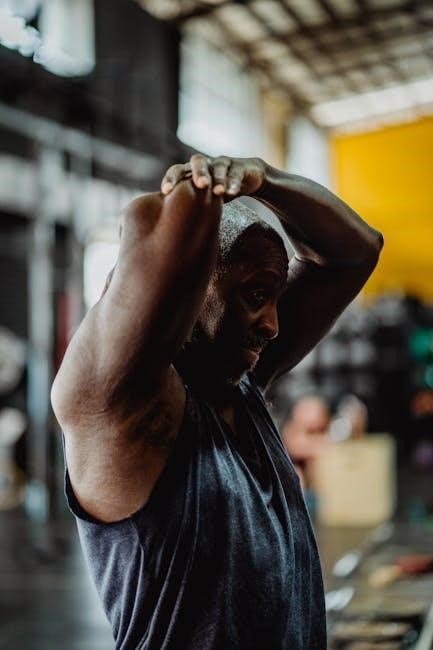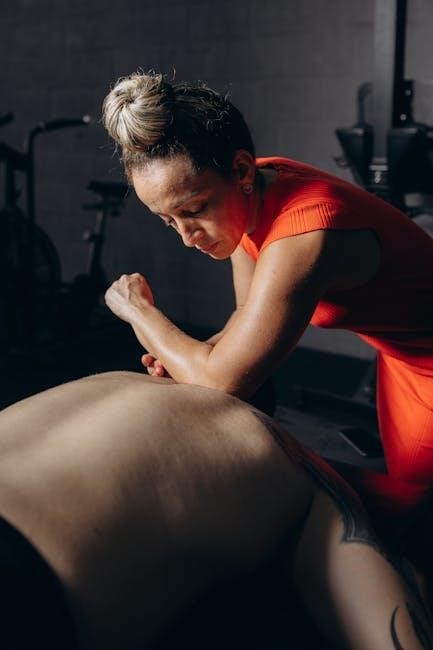Peroneal strengthening exercises are essential for improving ankle stability, preventing injuries, and enhancing overall lower limb function․ These exercises target the peroneal muscles, crucial for lateral ankle support and movement․ By incorporating specific techniques and progressive resistance, individuals can effectively strengthen their peroneal tendons, reducing the risk of chronic instability and promoting recovery․ This guide provides a comprehensive plan to help you achieve stronger, more resilient peroneal muscles through targeted workouts and proper execution․
1․1 Importance of Peroneal Muscles for Ankle Stability
The peroneal muscles play a vital role in providing lateral stability to the ankle, preventing excessive rolling or twisting․ They act as dynamic stabilizers, protecting the ankle from sprains and chronic instability․ Strengthening these muscles enhances proprioception and balance, reducing injury risks during sports or daily activities․ Weak peroneal muscles can lead to ankle instability, making their strengthening crucial for maintaining proper foot mechanics and overall lower limb function․
1․2 Benefits of Strengthening Peroneal Tendons
Strengthening the peroneal tendons enhances ankle stability, reduces injury risk, and improves overall lower limb function․ It boosts proprioception, critical for balance and movement․ Strong peroneal muscles also alleviate pain from conditions like tendonitis and chronic instability․ Additionally, strengthening these tendons supports recovery after injuries and surgeries, promoting long-term joint health․ Regular exercise prevents weakness and enhances athletic performance, ensuring optimal support during daily activities and sports․
1․3 Overview of the Exercise Plan
This comprehensive exercise plan focuses on progressive resistance, proper form, and dynamic stretches to strengthen the peroneal muscles․ It includes weight-bearing exercises, resistance band workouts, and balance training to improve ankle stability and function․ Designed for both beginners and advanced individuals, the plan emphasizes gradual intensity increases and incorporates rest periods for optimal recovery․ The structured approach ensures a safe and effective path to building strong, resilient peroneal tendons and achieving long-term ankle health․

Anatomy of the Peroneal Muscles
Peroneal muscles, including the Peroneus Longus and Brevis, are located on the outer lower leg, playing a crucial role in ankle stability and lateral movement․
2․1 Peroneus Longus and Peroneus Brevis
The Peroneus Longus and Brevis muscles are vital for lateral ankle stability and movement․ The Peroneus Longus runs from the fibula to the first metatarsal, supporting the arch during gait․ The Brevis, shorter and deeper, stabilizes the ankle during sideways movements․ Together, they prevent excessive inversion and eversion, crucial for dynamic balance and injury prevention․
2․2 Role in Ankle Movement and Stability
The Peroneus Longus and Brevis muscles play a critical role in ankle movement and stability․ They prevent excessive inversion and eversion, essential for balance and locomotion․ The Peroneus Longus supports the arch during walking, while the Brevis stabilizes the ankle during sideways movements․ Together, they enhance dynamic balance, reducing the risk of ankle instability and injuries, particularly during sports or uneven terrain activities․
2․3 Common Injuries and Weaknesses
Peroneal tendonitis and muscle strains are common injuries affecting the peroneal muscles, often due to repetitive stress or acute ankle sprains․ Chronic lateral ankle instability is another frequent issue, leading to persistent pain and weakness․ Weaknesses in the peroneal muscles can stem from inadequate strengthening, muscle imbalances, or poor ankle mechanics․ These factors make the peroneal tendons more susceptible to injury, particularly during activities like running or sports involving sharp turns․

Key Principles of Peroneal Strengthening
Progressive resistance, proper form, and dynamic stretches are key principles․ Strengthening peroneal muscles requires consistent practice and tailored exercises to enhance stability and prevent injuries effectively․
3․1 Progressive Resistance Training
Progressive resistance training is a cornerstone of peroneal strengthening․ It involves gradually increasing the intensity of exercises over time to build muscle endurance and strength․ This method helps prevent plateaus and ensures continuous improvement․ Using resistance bands, weights, or bodyweight, individuals can challenge their peroneal muscles effectively․ Consistency and careful progression are key to achieving optimal results without causing injury or overexertion․
3․2 Proper Form and Technique
Proper form and technique are vital for effective peroneal strengthening․ Maintaining correct posture and alignment ensures targeted muscle engagement while minimizing injury risk․ Focus on slow, controlled movements during exercises like plantarflexion and dorsiflexion․ Avoid compensating with other muscle groups, as this can reduce exercise efficacy․ Using tools like resistance bands or weights requires precision to maintain form․ Prioritize quality over quantity to achieve optimal results and prevent overexertion or pain during workouts․
3․4 Incorporating Dynamic Stretches
Incorporating dynamic stretches enhances flexibility and prepares the peroneal muscles for exercise․ Start with ankle plantarflexion and dorsiflexion, moving through controlled ranges of motion․ Use a towel for resistance if needed, holding stretches for 15-30 seconds․ Dynamic stretches like calf raises and lateral ankle swings improve circulation and reduce injury risk․ Perform these stretches before workouts to optimize muscle activation and prevent stiffness, ensuring a smooth transition into strengthening exercises․

Types of Peroneal Strengthening Exercises
Peroneal strengthening exercises include weight-bearing activities, resistance band workouts, and balance training․ These methods target ankle stability, muscle endurance, and functional strength, ensuring comprehensive lower limb fitness․
4․1 Weight-Bearing Exercises
Weight-bearing exercises are fundamental for peroneal strengthening, focusing on standing activities that engage the ankles and lower legs․ These exercises, such as calf raises and single-leg stands, improve ankle stability and muscle strength․ By performing these movements, individuals enhance their peroneal muscle endurance and functional mobility, reducing the risk of injuries and improving overall lower limb performance․
4․2 Resistance Band Exercises
Resistance band exercises are highly effective for strengthening the peroneal muscles․ Portable and versatile, these exercises target the peroneal tendons through controlled movements․ Seated or standing eversion exercises, where the foot is moved outward against the band, are particularly beneficial․ By gradually increasing resistance, individuals can enhance muscle strength and lateral ankle stability․ These exercises are ideal for both rehabilitation and prevention, promoting functional mobility and reducing injury risk․
4․3 Balance and Proprioception Training
Balance and proprioception training enhances ankle stability by improving neuromuscular control․ Using tools like a wobble board or balance pad, individuals can perform single-leg exercises to challenge their peroneal muscles․ These exercises strengthen the connection between nerves and muscles, reducing the risk of ankle instability․ Incorporating dynamic stretches and controlled movements further improves functional mobility and resilience․ Regular practice helps prevent injuries and enhances overall lower limb coordination, making it essential for both rehabilitation and injury prevention programs․
Sample Workout Routine
This routine includes targeted exercises like calf raises, resistance band work, and single-leg balances․ Perform 3 sets of 12-15 reps, 2-3 times weekly for optimal results․
5․1 Basic Exercises for Beginners
Begin with simple exercises like ankle alphabet, where you trace letters with your foot, and seated calf raises to strengthen the peroneal muscles․ Use resistance bands for gentle stretches and ankle eversions․ Incorporate single-leg stands to improve balance and stability․ Start with 2-3 sets of 10-12 repetitions, focusing on proper form․ Gradually increase intensity as strength improves․ These foundational exercises build a strong base for more advanced routines, ensuring safety and effectiveness for newcomers․
5․2 Advanced Exercises for Strength Building
Advanced exercises include weighted heel raises, lateral hops, and dynamic stretches using high-resistance bands․ Incorporate plyometric movements, such as single-leg box jumps, to enhance power and stability․ Progress to balance exercises on unstable surfaces like BOSU balls or wobble boards․ Use progressive overload by increasing weight or resistance to challenge the peroneal muscles further․ These exercises build significant strength, improve functional movement, and reduce injury risk, ensuring continued progress for experienced individuals․
5․3 Example PDF Exercise Plan
A sample PDF exercise plan for peroneal strengthening includes a structured 4-week program with warm-up routines, progressive exercises, and cool-down stretches․ The plan categorizes exercises into beginner, intermediate, and advanced levels, ensuring gradual muscle adaptation․ It features detailed instructions, illustrations, and a weekly schedule to track progress․ The PDF also includes tips for proper form, injury prevention, and nutrition advice to support muscle recovery and growth, making it a comprehensive guide for effective peroneal strengthening․
Common Mistakes to Avoid
Overexertion can lead to injury, while poor form reduces exercise effectiveness․ Ignoring proper warm-ups increases the risk of strain, so prioritize technique and gradual progression in workouts․
6․1 Overexertion and Pain
Overexertion during peroneal strengthening exercises can lead to pain and setbacks․ It’s crucial to avoid pushing through discomfort, as this may cause further injury․ If pain occurs, stop the exercise immediately and rest․ Modifying exercises to suit your current strength level can help prevent overexertion․ Gentle progression is key to safe and effective strengthening․ Always prioritize pain-free movement to ensure proper healing and avoid prolonged recovery times․
6․2 Poor Form and Technique
Poor form and technique during peroneal strengthening exercises can lead to ineffective workouts and increased risk of injury․ Proper alignment and movement are essential to target the correct muscles and avoid strain․ Using mirrors or guidance from professionals can help maintain correct posture․ Consistently practicing good form ensures optimal muscle engagement and reduces the likelihood of imbalances or overuse injuries․ Always prioritize technique to achieve safe and effective results․
6․3 Insufficient Warm-Up
Insufficient warm-up before peroneal strengthening exercises can lead to muscle strain and injury․ It is crucial to prepare the muscles with dynamic stretches and light cardio to improve blood flow and flexibility․ Skipping this step increases the risk of discomfort or harm, especially for the peroneal tendons․ Always prioritize a proper warm-up routine to ensure safe and effective workouts, promoting optimal performance and reducing the likelihood of setbacks during your exercise plan․
Recovery and Rehabilitation
Proper recovery and rehabilitation are vital for healing and strengthening peroneal muscles․ Consistent rest, ice therapy, and gentle stretching support tendon repair and prevent future injuries, ensuring progress in your exercise plan․
7․1 Rest and Ice Therapy
Rest and ice therapy are fundamental for peroneal muscle recovery․ Applying ice for 15-20 minutes, 2-3 times daily, reduces inflammation and promotes healing․ Adequate rest prevents overexertion, allowing tendons to repair․ During rest periods, avoid high-impact activities to ensure proper recovery․ This combination supports tendon repair, enhances stability, and prevents further injury, making it essential for effective rehabilitation and strengthening programs․
7․2 Foam Rolling and Self-Myofascial Release
Foam rolling and self-myofascial release are effective techniques for improving muscle recovery and reducing tension in the peroneal muscles․ By rolling the lower leg and calf, you can enhance blood flow and flexibility․ These methods help break down adhesions and scar tissue, promoting faster healing․ Regular foam rolling can also reduce muscle soreness and improve range of motion, making it an essential complement to any peroneal strengthening program․
7․3 Stretching for Flexibility
Stretching is crucial for maintaining and improving flexibility in the peroneal muscles․ Techniques like towel stretches and calf stretches can enhance range of motion and reduce muscle tension․ Regular stretching, 2-3 times weekly, helps prevent tightness and promotes recovery․ Focus on static stretches held for 15-30 seconds, such as the peroneal stretch and gastrocnemius stretch․ Dynamic stretches before workouts can also improve flexibility and reduce injury risk․

Troubleshooting Pain and Plateaus
Address pain by modifying exercises or incorporating low-impact activities․ Overcome plateaus with progressive resistance or changing routines․ Seek professional guidance for persistent issues or stagnation․
8․1 Addressing Pain During Exercises
Experiencing pain during peroneal exercises is common but should not be ignored․ If sharp pain or dull discomfort arises, stop the exercise immediately․ Apply the RICE method (Rest, Ice, Compression, Elevation) to reduce inflammation․ Modify your routine by reducing resistance or switching to low-impact activities․ CONSULT A PHYSICAL THERAPIST OR MEDICAL PROFESSIONAL for persistent pain to avoid further injury and ensure proper rehabilitation․ Adjusting your technique or taking regular breaks can also alleviate discomfort․
8․2 Overcoming Strength Plateaus
To overcome strength plateaus in peroneal training, gradually increase resistance or intensity․ Incorporate varied exercises like single-leg balances or resistance band work․ Ensure proper form to maximize muscle engagement․ Periodically assess and adjust your routine to avoid stagnation․ If progress stalls, consult a physical therapist for tailored strategies․ Adequate rest, nutrition, and consistency are key to breaking through plateaus and achieving continued strength gains in the peroneal muscles․
8․3 Adjusting the Exercise Plan
Regularly reassess your progress and adjust the exercise plan to avoid plateaus․ Incorporate new exercises, vary resistance levels, or alter repetitions․ Ensure proper technique and gradually increase intensity․ If pain persists or progress stalls, consult a healthcare professional to modify the plan․ Tailoring the routine to individual needs ensures continued improvement and prevents overtraining․ Adjustments should align with current fitness levels and goals, promoting sustained progress in peroneal strength and stability․
Consistent practice of peroneal strengthening exercises enhances ankle stability, reduces injury risk, and improves overall lower limb function․ Dedication to the plan yields long-term benefits and strength․
9․1 Summary of Key Points
Peroneal strengthening exercises are vital for enhancing ankle stability, reducing injury risk, and improving overall lower limb function․ The exercises target the peroneal muscles, which play a crucial role in lateral ankle support and movement․ By incorporating weight-bearing exercises, resistance bands, and balance training, individuals can effectively strengthen their peroneal tendons․ The guide emphasizes the importance of consistent practice, proper form, and recovery techniques like rest and ice therapy to achieve long-term benefits and prevent chronic instability․
9․2 Encouragement for Consistent Practice
Consistency is key to achieving strong, stable peroneal muscles․ Regular practice reinforces muscle memory and gradually builds strength, reducing injury risks․ Stay motivated by tracking progress and celebrating small victories․ Even brief, daily exercises can yield significant improvements over time․ Remember, every effort contributes to long-term ankle health and overall mobility․ Commit to your routine and embrace the journey toward stronger, more resilient peroneal muscles for a healthier, active lifestyle․
